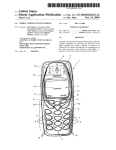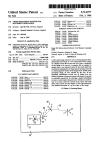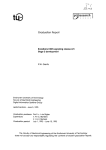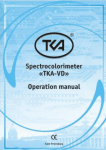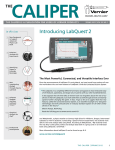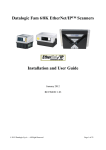Download Particle in a Box
Transcript
Particle in a Box 114430 Februari 2013 1 PRODUCT CONTENTS Quantity Description 1 vial 1 vial 1 vial 1 vial 1 Red Quantum Dot solution Orange Quantum Dot solution Yellow Quantum Dot solution Green Quantum Dot solution Aluminum rack OTHER SUGGESTED MATERlALS Spectrofotometer SpectroVIS Light source 405 nm (Required) SpectroVis Optical fiber 113120 114432 113121 ASSEMBLY OF APPARATUS The apparatus is held securely in place by two hex bolts, which can be unscrewed to allow removal of the vials for testing. The glass vials containing the quantum dots, provided by Nanosys, should be left in the rack upright at all times unless being tested. The vials are sealed with aluminum caps and are never meant to be opened or punctured. If they are opened, cracked or leaking please consult the MSDS sheet immediately. CARE/MAINTENANCE OF DEVICE The rack with vials should always be kept in an upright position and stored in a temperature range of 50°F to 80°F. When the vials are removed from the rack take care to not damage the Aluminum PTFE seal. Please read the included MSDS before perfoming any demonstrations or experiments. If you should experience any difficulty with the apparatus, please contact us, giving details of the problem. To ensure maximum service, do not return any apparatus until we have given you authorization. COPYRIGHT NOTICE The Quantum Dots operating instructions are copyrighted and all rights reserved. Permission is granted to all non-profit educational institutious to make as many copies of these instructions as they like as long as it is for the sole purpose of teaching students. Reproduction by anyone for any other reason is prohibited. Eurofysica B.V. | Postbus 3435 | 5203 DK ’s-Hertogenbosch | tel. +31(0)73 623 26 22 | fax. +31 (0)73 621 97 21 | www.eurofysica.nl | [email protected] Particle in a Box 114430 Februari 2013 2 DESCRIPTION OF USE/BACKGROUND INFORMATION Along with general relativity, quantum mechanics is one of the most significant advances in modern physics. While very important and becoming increasingly so with the advent of nanotechnology, the concepts of quantum mechaillcs are sometimes difficult to teach,owing to their abstract and non-intuitive nature. Nanosys has developed a product (Figure 1) that uses nanotechnology to allow students to readily grasp the underlying principles and implications of quantum mechanics. Figure 1. Nanosys Quantum Dots illustrating multiple emissions.from a single excitation source The underpinnings of quantum mechanics came about in the early 1900s with the introduction of the concept of wave-particle duality, a theory stating that particles can exhibit wave-like properties and vice versa. In 1905, Albert Einstein explained the photoelectric effect by proposing that light-waves also have particle-Iike characteristics ("photons"). In 1913, Niels Bom explained the quantized energy states and spectral lines of the hydrogen atom by proposing that electrons have wave-like characteristics (electron orbitals). Finally, in 1924, Louis de Broglie put forward his complete theory of matter waves, solidifying the universal concept of wave-particle duality. Wave-particle duality and the quantized nature of energy in quantum systems represent two of the central elements of quantum mechanics. Bohr's model of the hydrogen atom is perhaps the most commonly known quantum theory. Bohr calculated the energy levels associated with an electron in each orbital based on the wavelength of the electron orbiting the nucleus. As an electron moves up in energy levels it absorbs a specific amount of energy, or quanta of energy. When the electrons fall down to a more stabIe energy level the same quanta of energy is emitted in the form of light. While the theory was useful for simple systems such as a hydrogen atom, more complex systems could not be understood until the development of the Schrodinger equation by Erwin Schrodinger in 1925. The Schrodinger equation represents a fundamental tooI in understanding and using quantum mechanics even today. ParticIe in a Box One problem that allows a student of chemistry or physics to understand the implications of quantum mechanics is the "particle in a box" problem, in which the the Schrodinger equation is used to calculate the wave-like characteristics (known as the "wavefunction") and energy levels of a quantum mechanical particIe trapped inside a one-dimensional box. In this problem, we conceptualize a single particle bouncing around inside of an immovable box, from which it cannot escape, and which loses no energy when it collides with the walls of the box. In classical mechanics (otherwise known as Newtonian mechanics), the solution to the problem is trivial. The particle moves in a straight line, always at the same speed, until it reflects from a wall. Eurofysica B.V. | Postbus 3435 | 5203 DK ’s-Hertogenbosch | tel. +31(0)73 623 26 22 | fax. +31 (0)73 621 97 21 | www.eurofysica.nl | [email protected] Particle in a Box 114430 Februari 2013 3 (Figure 2a). When it reflects from a wall, it always reflects at an equal but opposite angle to its angle of approach, and its speed does not change. In quantum mechanics, however, when the wave-like character of the particIe is considered, the results are much more surprising. Nevertheless, it remains a very simple and solvable problem (Figure 2b). In this case, the wavefunction of the particIe can be conceptualized as a vibrating string that is fixed at the walls of the box. As a result, only certain wavelengths (and therefore energies) can exist for the particle (Figure 2b). Figure 2. Particle in Box a) Classical Representation b) Wave Representation Overall, the wave like property of this theoretical partical in a box, illustrates the following features of quantum mechanics: 1. Energy quantization -lt is not possible for the particle to have any arbitrary energy. Only specific, discrete energy levels are allowed. 2. Zero-point energy - The lowest possible energy level of the particle, called the zero-point energy, is nonzero. 3. Spatial nodes - The Schrödinger equation predicts that for some energy levels there are nodes, implying positions at which the particIe can never be found . Quantum Dots (a real-world particIe in a box) While the particle in a box problem serves to explain some of the unique implications of quantum mechanics, it is not something that can easily be seen or tested in real life. As such, these fundamental concepts are often very difficult for students to grasp, since there is no good real-world example they can use to "see" these effects. Quantum Dots, however, are a real-world particle in a box. Quantum Dots (Figure 3) are small semiconductor particles that can contain electrons. Just like in the semiconductors that are used to make Flash cards and microprocessors, these electrons can move freely inside the semiconductor, but cannot get out (just like a particle in a box!). A Quantum Dot provides a unique way to teach core concepts associated with quantum mechanics such as energy quantization and wave-particle duality as well as the 3 features stated above. This Nanosys product uses Quantum Dots to give the student a hands-on feel for the implications of quantum mechanics, while exposing student to cutting edge nanotechnology. Figure 3. Micrograph of 5 nm Quantum Dot. Each bright point represents a single atom. This image was taken with a transmission electron microscope. Eurofysica B.V. | Postbus 3435 | 5203 DK ’s-Hertogenbosch | tel. +31(0)73 623 26 22 | fax. +31 (0)73 621 97 21 | www.eurofysica.nl | [email protected] Particle in a Box 114430 Februari 2013 4 Experiment Guide: High School 114430 Quantum Dots Experiment 1 - Classroom Demonstration A. Theory/derivation of formulas This simple product can be used to expand upon elements within the high school curriculum such as waveparticIe duality, quantization of energy, and the Bohr model of the atom. By using optical measurements such as florescence, the students will be able to use this lesson with tools commonly available within the high school lab. Florescence is the emission of light from a substance after it has absorbed energy. The absorbed energy can be in the form of electricity, light, heat or other forms of energy. In the case where the absorbed energy is provided in the form of light, the emitted wavelength is often of lower energy (longer wavelength, red end of the spectrum) than the absorbed energy (shorter wavelength, blue end of the spectrum). Since violet has the highest energy (shortest wavelength) of the visible spectrum, it is used in this lesson to "excite" the quantum dots. Additionally, even though the same light source is used to illuminate the different solutions of quantum dots, their physical size limits the energy each one re-emits. Small dots will florescence blue while large dots will florescence red. Wave particle duality can be readily taught using this teaching aid to introduce students to the particle in a box concept. In it's simplest form, wave particle duality can be taught be conceptualizing matter waves as skipping ropes or waves in pool. With this concept and the constaint that the wave must be pinned at the walls of the box, we are able to illustrate the key feature of a wave particIe duality. For quantum dots, mathematically this is expressed as: where R is the radius of the Quantum Dot, me is the effective mass of the electron inside the semiconductor, mh is the effective mass of a hole (the absence of an electron) inside the semi conductor and Eg is the bandgap energy of the semiconductor. -19 Eg = 2.15 X 10 J. -32 me = 7.29 X 10 kg -31 mh = 5.47 X 10 kg The first 2 terms of this formula illustrates the size scale at which these wave particle duality effects begin to dominate given that the 3rd term is a bulk material (or macroscopic world term) and illustrates how these effects become important when dealing with very small length scales. Eurofysica B.V. | Postbus 3435 | 5203 DK ’s-Hertogenbosch | tel. +31(0)73 623 26 22 | fax. +31 (0)73 621 97 21 | www.eurofysica.nl | [email protected] Particle in a Box 114430 Februari 2013 5 B. Setup/Procedure Classroom Demonstration 1. Using an LED close to 400 nm illuminate each vial so the class can see the emanations from each (shutting the lights off makes the demonstration more visible). Explain to the class that the vials all contain the same solution; the only difference between them is the physical size of the quantum dots contained in each (i .e. the size of the "box"). Define quantum dots as small crystals 10 - 50 times the diameter of an atom. 2. After illuminating each vial, ask the class to brainstorm about the size of the quantum dots in each vial based on the color the vial radiated. Ask for a volunteer to write the colors on the board in order from smallest to largest quanturn dots. C. Data and Calculations Based on the colors that you observed, calculate the radius of the quantum dots for each color using equation 1 a. The colors of the visible light spectrum Color wavelength interval red ~ 625-660 nm orange ~ 590-625 nm yellow ~ 565-590 nm green ~ 500-565 nm cyan ~ 485-500 nm blue ~ 440-485 nm violet ~ 380-440 nm D. Questions 1. Why is a violet LED used instead of a red LED? 2. Plot the quantum dot radius versus the emitted wavelength, what relationship do you see? 3. What happens if the radius of the quantum dot gets very large (approaching infinity)? Eurofysica B.V. | Postbus 3435 | 5203 DK ’s-Hertogenbosch | tel. +31(0)73 623 26 22 | fax. +31 (0)73 621 97 21 | www.eurofysica.nl | [email protected] Particle in a Box 114430 Februari 2013 6 Experiment Guide: College Experiment 1 - Classroom Demonstration A. Theory/derivation of formulas Introduction to the Time-Independent Schrödinger Equation: Within the context of wave-particle duality, the Schrödinger Equation defines the relationship between the wave-like characteristic of a particle, known as the "wavefunction", and its energy. The Schrödinger equation states where Ψ is the wavefunction of the particle, H is the Hamiltonian Operator and E is the energy of the system. For a simple one-dimensional system, such as the one-dimensional particle in a box described in this lesson, the Hamiltonian Operator is defined as the sum of the kinetic and potential energy, which can then be rewritten in the format below. where ħ is the reduced Planck Constant ( ) m is the mass of the particle and V(x) is the potential experience by the particle as a function of location. For a particle with a one-dimertsional wavefunction Ψ(x) , the complete time-independent Schrödinger equation is therefore Problem: Particle in a Box Using the Schrödinger Equation (1c), find the wavefunction and energy levels for a particle trapped inside a one dirnensional box. where the potential inside the box is zero and outside the box is infinite (also known as a "particle in a box"). Eurofysica B.V. | Postbus 3435 | 5203 DK ’s-Hertogenbosch | tel. +31(0)73 623 26 22 | fax. +31 (0)73 621 97 21 | www.eurofysica.nl | [email protected] Particle in a Box 114430 Februari 2013 7 In this potential, a particle is completely free inside the box, but at the two boundaries the infinite potential keeps it from leaving the potential weIl. In other words the probability of the particle being outside the box is zero. Please note that the mathematical representation of the well from zero to L is to provide the easiest scenario for solving the wave equation. Solution to the particIe in a box problem Since the potential inside of the weIl (our region of interest) is zero (V(x) =0) we can simplify the Schrödinger Equation to the following form: which can be rewritten as: Since the energy of the system cannot be negative (E ≥ 0), we can define a new variable k, such that so that the complete Schrödinger Equation can be simplified to This simple differential equation has the general solution: Where This is the general form of the wavefunction and energy of a particle in free-space. We have not yet, however, applied the boundary conditions imposed by the infinite potential weIl (the "box"). Since the potential outside the box is infinite, the wavefunction must go to zero at the edges of the box. Therefore, ln order for the wavefunction to go to zero at the left-hand waIl (x=0), the boundary condition then implies that the B must equal zero, which leaves us with: Eurofysica B.V. | Postbus 3435 | 5203 DK ’s-Hertogenbosch | tel. +31(0)73 623 26 22 | fax. +31 (0)73 621 97 21 | www.eurofysica.nl | [email protected] Particle in a Box 114430 Februari 2013 8 In order for the wavefunction to go to zero at the right-hand wall (x=L), the boundary condition then implies that Therefore, and the wave function takes the form: with The final step is to determine the value of A. The probability of finding a particle with wavefunction Ψ (x) at any particular location (x) is determined by taking the square ofthe absolute value of the wavefunction at that location, Since we know that the probability of finding the particle somewhere inside the box is 100% (i.e. the particle cannot exist outside of the box), then so that Therefore, our final wavefunction and energy levels are: Eurofysica B.V. | Postbus 3435 | 5203 DK ’s-Hertogenbosch | tel. +31(0)73 623 26 22 | fax. +31 (0)73 621 97 21 | www.eurofysica.nl | [email protected] Particle in a Box 114430 Februari 2013 9 This simple example of a particle in a one-dimensional box highlights three important implications of quantum mechanics: 1. Energy quantization - while a classical particle trapped inside a box can have any energy (i.e. it can move back and forth across the box at any speed), according to the energy equation above, the wave-particle duality of quantum mechanics causes the quantum mechanical particle in a box to only have certain discrete (quantized) energies. 2. Zero-point energy - while a classical particle trapped inside a box can have zero energy (i.e. sit motionless), according to the energy equation above, the lowest possible energy state (for n=1) is not zero. 3. Spatial nodes - while a classical particle moving back and forth inside a box will spend an equal amount of time at all locations in the box, and therefore have an equal probability of being found at any particular locaiton, the wavefunction equation above implies that the probability of finding the particle at different locations is not uniform. In fact, there are locations within the box where the particles can never be found ("spatial nodes"), such as at the edges of the box since the wavefunction goes to zero at the edges of the box. For energy states with n>1, additional spatial nodes can be found in the interior of the box (Figure S1). Figure S1: Wavefunctions for a quantum mechanical particIe in a box for various values of n. The probability of finding the particIe is zero at each point where the wavefunction crosses the dashed blue line. Quantum Dots (a real-world particIe in a box) While the particle in a box problem above serves to explain some of the unique implications of quantum mechanics, it is not something that can easily be seen or tested in real life. As such, these fundamental concepts are often very difficult for students to grasp, since there is no good real-world example they can use to "see" these effects. Quantum Dots, however, are a real-world particle in a box. Quantum dots are small semiconductor particles that can contain one electron and one "hole" (the absence of an electron). Just like in the semiconductors that are used to make Flash cards and microprocessors, these electrons and holes act like small particles which can move freely inside the semiconductor, but cannot get out (Just like a particle in a box!). By carefully observing Quantum Dots with different sizes, we can see the effect of changing the size of the box (L) on the energy levels of the system. Eurofysica B.V. | Postbus 3435 | 5203 DK ’s-Hertogenbosch | tel. +31(0)73 623 26 22 | fax. +31 (0)73 621 97 21 | www.eurofysica.nl | [email protected] Particle in a Box 114430 Februari 2013 10 Of course, we must make some small adjustments to the particle in a box equation derived above to take into account some of the differences between this real-world particle in a box and our ideal model. First, the box is 3-dimensional and spherical in shape rather than one-dimensional and square. While the calculation is somewhat more complex (see appendix for full derivation), the lowest energy state (zero-point energy) for a particle in a sphere has a very similar form to that derived for the one-dimensional particle in a box: Second, there are actually two particles within each quantum dot rather than just one (the electron and the hole), so where R is the radius of the Quantum Dot, me is the effective mass of the electron inside the semi conductor, and mh is the effective mass of the hole inside the semiconductor. Finally, unlike the derivation above, our Quantum Dot "box" is not empty, but is filled with a semiconductor. As such, there is an additional base-line energy that must be added to the system that comes from the energy of the semiconductor bandgap (Eg). Therefore, a simple model of the Quantum Dot zero point energy is described by B. Setup/Procedure 1. Using an LED close to 400 nm illuminate each vial so the class can see the luminescence (shutting the lights off makes the demonstration more visible). Explain to the class that the vials all contain the same solution the only difference is the physical size of the quantum dots contained in each. Define quantum dots as small crystals 10 50 times the diameter of an atom. 2. After illuminating each vial, ask the class to brainstorm about the size of the quantum dots in each vial based on the color the vial radiated. Ask for a volunteer to write the colors on the board in order from smallest to largest quantum dots. C. Questions 1. Why is a violet LED used instead of a red LED? Eurofysica B.V. | Postbus 3435 | 5203 DK ’s-Hertogenbosch | tel. +31(0)73 623 26 22 | fax. +31 (0)73 621 97 21 | www.eurofysica.nl | [email protected] Particle in a Box 114430 Februari 2013 11 Experiment 2 - Determining the size of a Quantum Dot A. Theory/derivation of formulas Using the theory section from Experiment 1- Classroom Demonstration a solution for the three dimensional case can be derived. This is left as an exercise for either the student or teacher. Since we will use the wavelength (color) of the fluorescence from the Quantum Dots to measure the zero-point energy, we must also convert this wavelength information to energy using where E, v and λ are the energy, frequency and wavelength of the emitted light, c is the speed of light (3 x 108 mIs) . and h is Plank's Constant (6.62x10-34 J s) B. Setup/Procedure Each brand of spectrometer will have slightly different operating instructions so please follow your user manual. The following is designed for the SpectroVis spectrometer. Procedure: 1. Carefully remove one of the vials from the aluminum rack by using a hex key, loosening both hex bolts. 2. Set the vial upright on a flat surface free of other obstructions. 3. Set up the spectrometer probe so it is held stationary and pointed at the solution in the vial. 4. Turn off the lights or cover the apparatus to improve the quality of the readings. 5. Turn on the spectrometer and have the software ready to scan the wavelengths. 6. The 400 nm light source needs to be illuminating the vial but perpendicular to the spectrometer probe. See Figure S2 on the next page. If the light source is directly across from the probe you will not get an accurate reading of the wavelength radiated by the solution. 7. Turn on the 400 nm light source with it pointed at the solution. 8. Initiate the software to record the radiated wavelengths. 9. Using the peak wavelength and the formula from Section A( Theory/Derivation), calculate the size of the quantum dots. Eurofysica B.V. | Postbus 3435 | 5203 DK ’s-Hertogenbosch | tel. +31(0)73 623 26 22 | fax. +31 (0)73 621 97 21 | www.eurofysica.nl | [email protected] Particle in a Box 114430 Februari 2013 12 Figure S2 - Set up with SpectroVis spectrometer OPTIONAL USES/EXPERIMENTS Determining the absorption of the Quantum Dot Solution A. Setup/Procedure Each brand of spectrophotometer will have slightly different operating instructions but overall the functions are the same. The following is design for the SpectroVis spectrophotometer Procedure 1. Since the vials are so small you need to use an adapter to fit the vial into the sample compartment. You will also need to place a 15 mm lifter in the bottom of the adapter as well to raise the solution to the level of the light source. 2. Starting at the lowest wavelength, zero out the unit and then insert the solution. 3. Record the data on the absorption ofthe solution, increasing the wavelength in increments of 10 nm. 4. Repeat steps 2 and 3 until you reach the upper limit of your spectrophotometer. 5. Repeat with each of the other three vials. Eurofysica B.V. | Postbus 3435 | 5203 DK ’s-Hertogenbosch | tel. +31(0)73 623 26 22 | fax. +31 (0)73 621 97 21 | www.eurofysica.nl | [email protected] Particle in a Box 114430 Februari 2013 13 DATA SECTION Experiment 2 - Determining the size of a Quantum Dot. 1. What was the peak wavelength for each vial? a. Red: b. Orange: c. Yellow: d. Green: 2. Using the formula from the Theory Section calculate the size of the Quantum Dots in each vial. (Show any work in the space below or on a separate paper) a. Red: b. Orange: c. Yellow: d. Green: 3. Find the percent error between your measured wavelength and dot radius versus the actual values provided by your instructor. a. Red: b. Orange: c. Yellow: d. Green: 4. Plot the quantum dot radius versus the emitted wavelength, what relationship do you see? Use graph paper. 5. What happens if the radius of the quantum dot gets very large (approaching infinity)? Eurofysica B.V. | Postbus 3435 | 5203 DK ’s-Hertogenbosch | tel. +31(0)73 623 26 22 | fax. +31 (0)73 621 97 21 | www.eurofysica.nl | [email protected] Particle in a Box 114430 Februari 2013 14 APPENDIX This derivation is intended as supplemental material to provide the full theoretical derivation from first principles to the fin al solution for the radius of the quantum dots. The experimental guides provide a more pedagogical approach to leaming about Schrödinger's wave equation. Solution to partical in a sphere In spherical co-ordinates At this point, we have not imposed boundary conditions. First solve for a free particle in spherical co-ordinates, and then impose boundaries to get quantization. Free particle V(r) = 0 We aIso know that for a free particle, E =h 2 k2 / 2m Therefore Define and raising and lowering operators: Must be true of raising and lowering operators Eurofysica B.V. | Postbus 3435 | 5203 DK ’s-Hertogenbosch | tel. +31(0)73 623 26 22 | fax. +31 (0)73 621 97 21 | www.eurofysica.nl | [email protected] Particle in a Box 114430 Februari 2013 15 But, from above, we know ^ ^ Show that dr & d1, are raising and lowering operators First, show that Also, Therefore Now, use along with previous results Therefore, Therefore, Eurofysica B.V. | Postbus 3435 | 5203 DK ’s-Hertogenbosch | tel. +31(0)73 623 26 22 | fax. +31 (0)73 621 97 21 | www.eurofysica.nl | [email protected] Particle in a Box 114430 Februari 2013 16 Now, determine Therefore These are the spherical Bessel functions Impose boundary conditions For 1=0 radia function (s orbitals) For free particle, Wavelength must go to zero at r = R Therefore Therefore Eurofysica B.V. | Postbus 3435 | 5203 DK ’s-Hertogenbosch | tel. +31(0)73 623 26 22 | fax. +31 (0)73 621 97 21 | www.eurofysica.nl | [email protected]

















